Objective
Agile coaching is about supporting a company success with Value, Speed and Quality in their production systems, at Scale, meaning that the system works no matter the size of the company.
The agile coach empowers the teams to come up with innovative solutions to the customers’ problems by making sure each team has clearly identified their purpose, has autonomy and is always improving, on their way to achieve mastery.
Achieving purpose, autonomy and mastery at scale, when the organisation goes beyond the 10-20 people, requires novel approaches to be implemented, drawing on best practices from system modelling, communication and facilitation, cultural and organisational design, technical and business excellence; this being a jack-of-all trades improver is where agile coaching shines.
Competencies
In the Adventure with Agile webinar on Agile Coaching (recording available on YouTube) Agile Coaching is defined by the following framework of competencies:
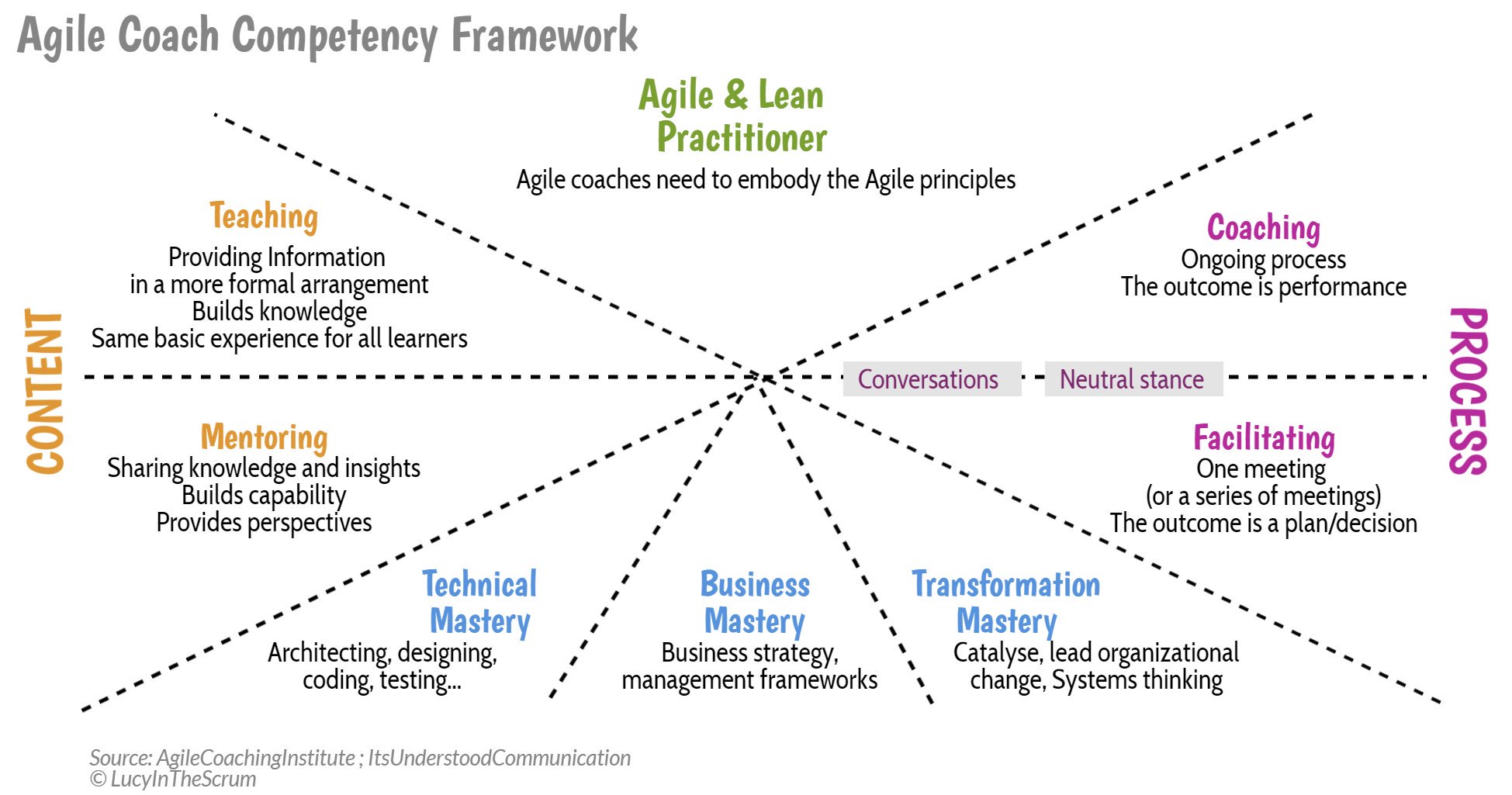
- Agile-Lean Practitioner: Ability to learn and deeply understand Agile frameworks and Lean principles, not only at the level of practices, but also at the level of the principles and values that underlie the practices enabling appropriate application as well as innovation.
- Professional Coaching: Ability to act as a coach, with the client’s interest determining the direction, rather than the coach’s expertise or opinion.
- Facilitating: Neutral process holder that guides the individual’s, team’s, or organization’s process of discovery, holding to their purpose and definition of success.
- Mentoring: Ability to impart one’s experience, knowledge and guidance to help grow another in the same or similar knowledge domains.
- Teaching: Ability to offer the right knowledge, at the right time, taught in the right way, so that individuals, teams and organizations metabolize the knowledge for their best benefit.
- Technical Mastery: Ability to get your hands dirty architecting, designing, coding, test engineering, or performing some other technical practice, with a focus on promoting technical craftsmanship through example and teaching-by-doing. And, expertise in agile scaling patterns or structures.
- Business Mastery: Ability to apply business strategy and management frameworks to employ agile as a competitive business advantage such as Lean Start-Up, product innovation techniques, flow-based business process management approaches, and other techniques that relate to innovating in the business domain.
- Transformation Mastery: Ability to facilitate, catalyze and (as appropriate) lead organizational change and transformation. This area draws on change management, organization culture, organization development, systems thinking, and other behavioral sciences.
The Agile Coach applies the competencies above to People and Processes to create Behaviours and Environments that support the achievement of Results.
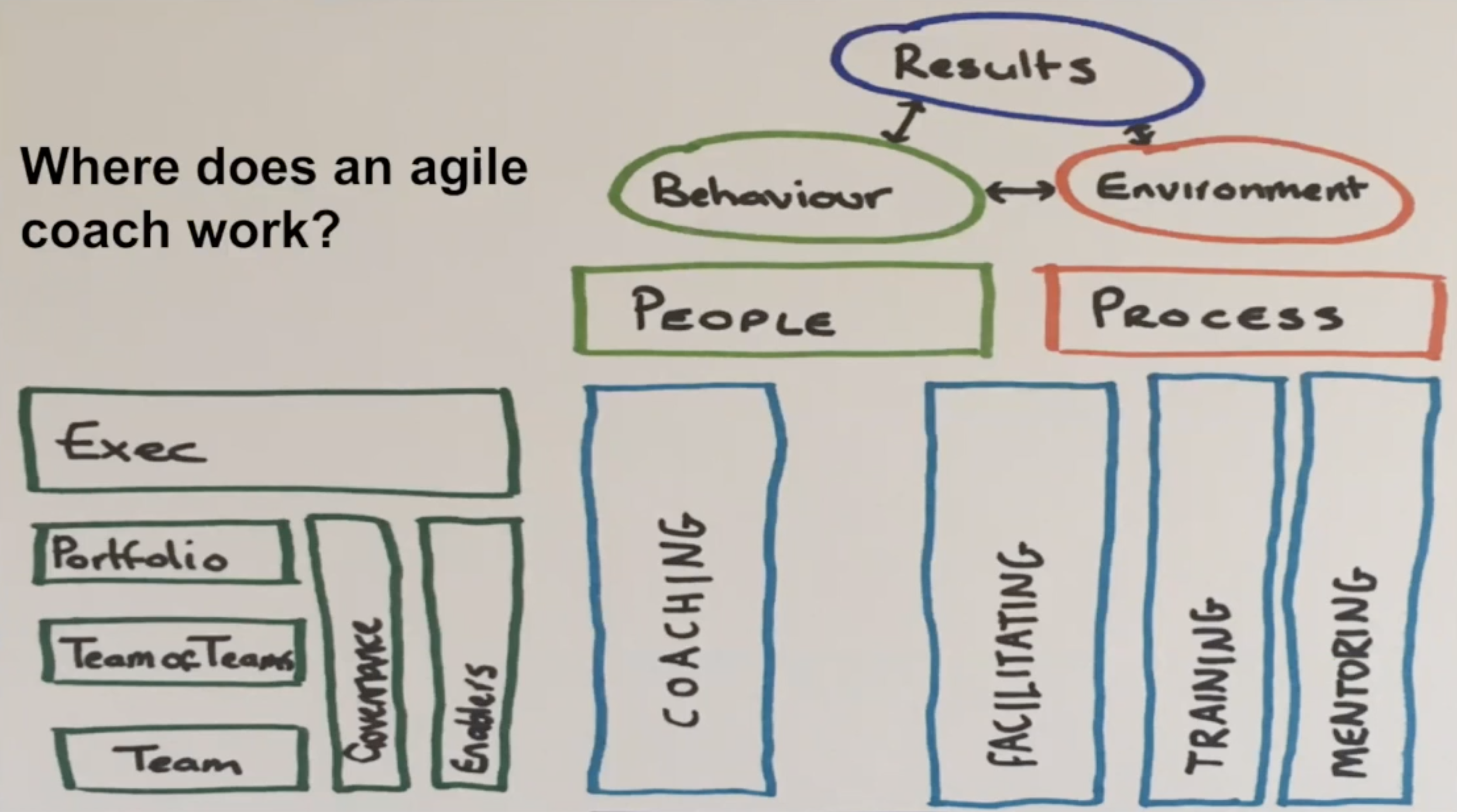
Based on the scope of the results desired, the Agile Coach works with one or more Organisational levels (Team, Team of Teams, Portfolio, Exec) to invite improvements that create High Performing Teams.
Elements & Hats
Another model, based on 8 different elements (hats) is presented by Mia Horrigan (ZenExMachina Agile Coach). The model is based on 8 elements:
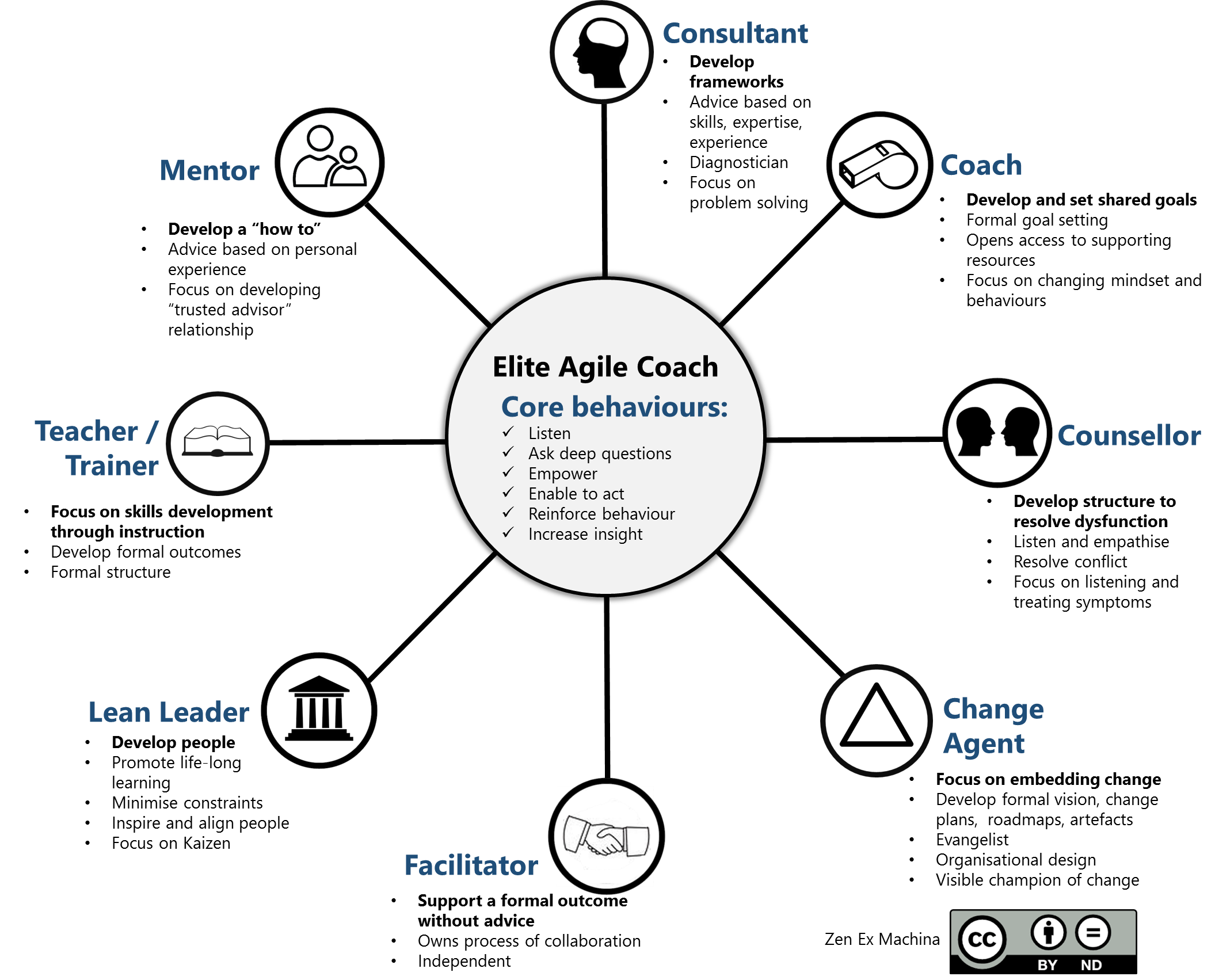
- Mentor: Develops ‘how to’s
- Consultant: Develops frameworks
- Coach: Develops and sets shared goals
- Counsellor: Develops structures to resolve disfunction
- Change Agent: Focusses on embedding change
- Facilitator: Supports a formal outcome without advice
- Lean Leader: Develops people
- Trainer/Teacher: Focuses on skills development through instruction
This model has done away with the technical, business and transformation masteries, enabling the model to apply to any domain whether the coach has a technical background or whether the coach is coaching in technical, design or business environment; the coaching competencies have been turned into the following key behaviours:
- Listening with empathy
- Asking deep questions
- Empowering people
- Enabling people to act
- Reinforcing agile behaviours
- Increasing insight
This model gives coaches a language they can use for discussion as not only a shared way of addressing issues but also to recognise strengths in each other’s coaching styles.
Using this Model
With this model on hand, coaches can analyse organisational, projects and people challenges, issues and capability growth opportunities and discuss which one should be tackled in the future.
Problem Solving
Let’s say you’re faced with a particularly prickly issue in your company.
The framework can help you determine which coaching element applies best to the context, based on the root cause, and which coach has the greatest strength in that area.
That coach (or coaches!) is then empowered to plan and remedy and / or support the issue at hand.
Personal Development
The framework can help an agile coach reflect on their capabilities.
There are many different ways that the wheel could be used in a coaching conversation, but it could go something like this:
- Talk through each of the competency areas. Maybe for each area roughly score yourself on a scale of 1 to 51;
- Some people will sell themselves short, others will overestimate their competence, your job as a coach is to try and hold them accountable to a true representation of themselves, ask for examples and be curious;
- Use the insight generated in the reflection to brainstorm options for growth and then formulate a plan of action. You can’t improve everything at once, so get the coachee to select an initial area of focus to work on.
Another approach for brainstorming is the Agile Coaching Framework Visual Walkthrough:
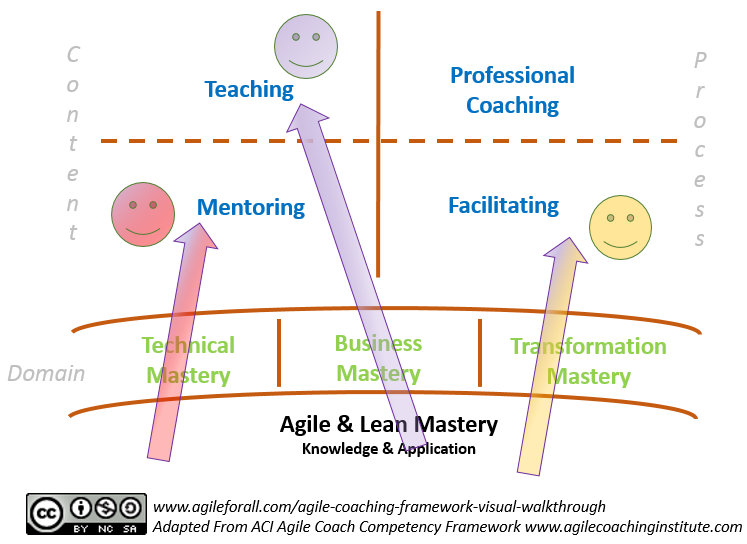
This diagram shows how someone may step into an agile coaching approach, with each arrow representing a different agile coach.
Each coach starts from the agile & lean mastery territory:
- The first person is focused on technical mastery and using a mentoring approach;
- The second person, business mastery and a teaching approach;
- The third person, transformation mastery and a facilitating approach.
Hiring and Team Development
After you’ve scored the coaches in your company, you can compare them to the challenges your company is facing and see if there is any gaps.
For example, if you are going to face a major strategic renewal and no coach in your organisation has a Transformational capability of 3 or more, you may want to start thinking about hiring some or developing this capability.
Heart of Agile
The Heart of Agile (HoA) is another interesting model for what areas can an Agile Coach lean into when faced with an issue.
To describe this learning and application journey, the HoA uses the Shu-ha-ri model, a Japanese martial art concept, which describes the stages a student progresses through three levels:
- Shu (obey): a student learns the basics from their teacher;
- Ha (digress): students may choose to digress from doing what they are told;
- Ri (separate): they don’t follow techniques as moves are now natural.
The HoA develops this model further by adding a new final state, Kokoro (heart): reaching a fundamental understanding of the basics, returning to “essence”, which is four words: Collaborate, Deliver, Reflect, Improve.
These words can then be further expanded to create new levels and actions to reflect on, which can help guides our paths to being an Elite Agile Coach:
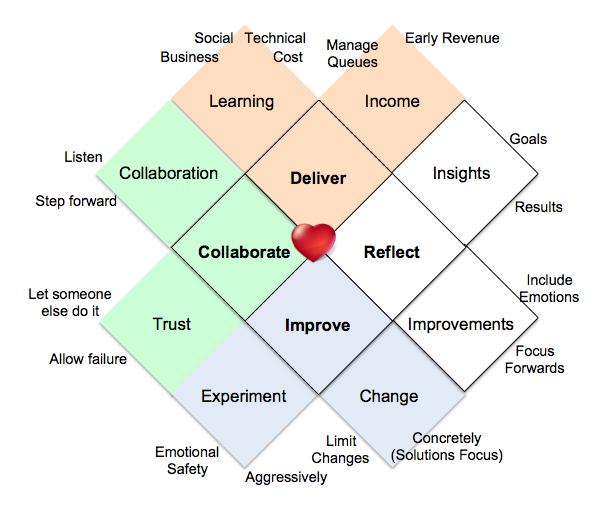
This model adapts well with the hats model:
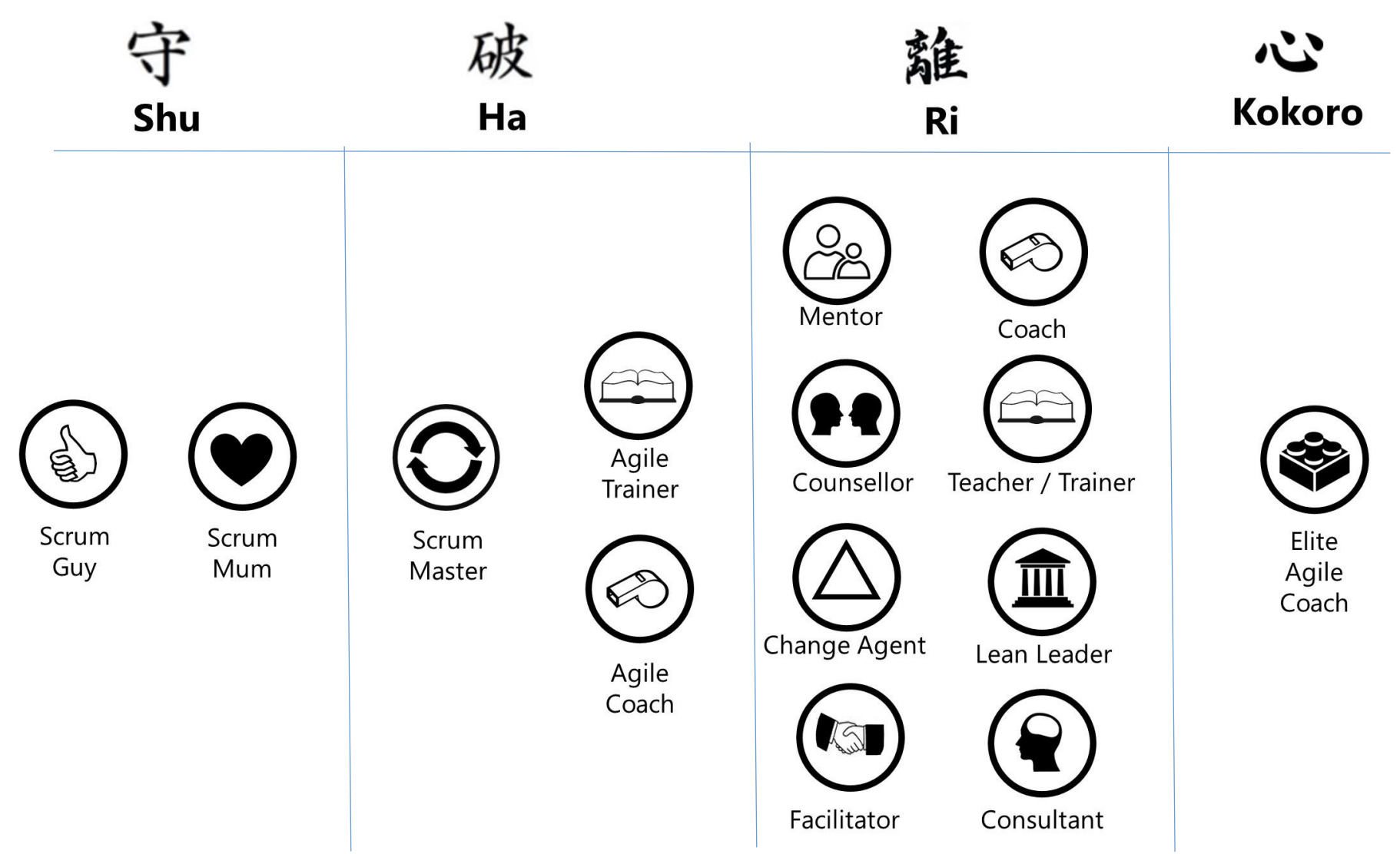
The First Step on the Path
The step from Shu to Ha is in my opinion the hardest: given “you don’t know what you don’t know”, it’s likely to stop here and never develop further. The below model goes in more details on the characteristics of a Scrum Mum / Guy vs a Scrum Master.
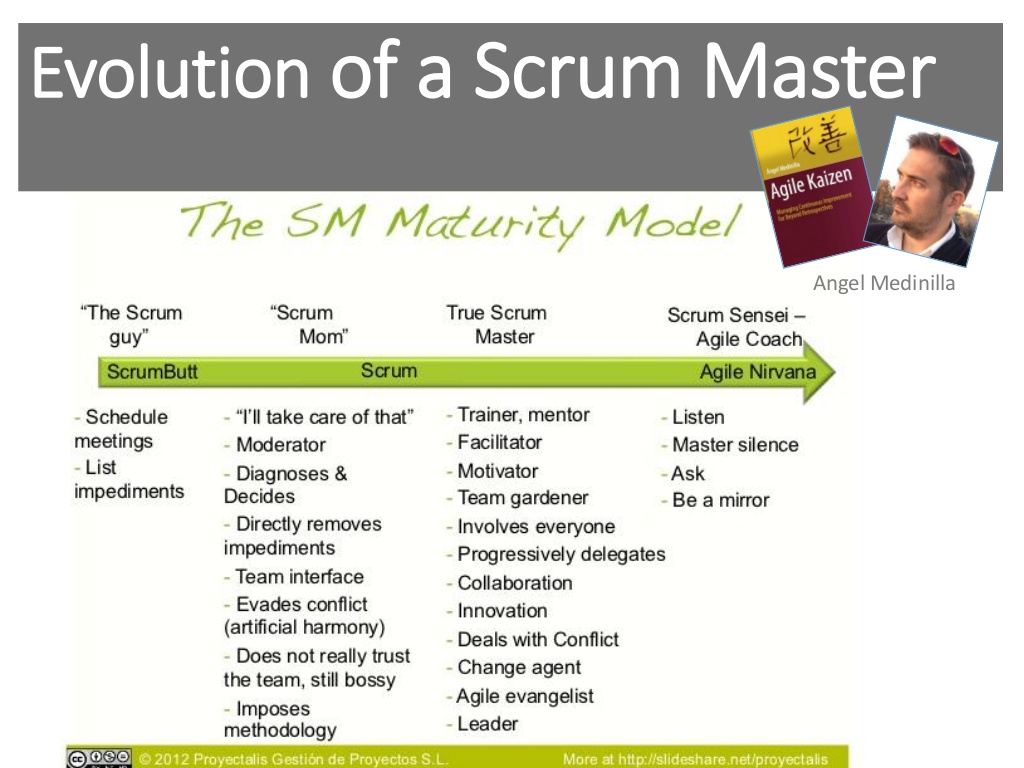
Related
Other Agile Pages
- September 08, 2018: Undone Work